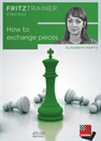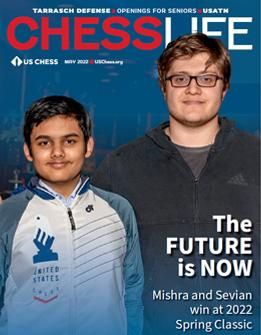Fresh and interesting play
By John Watson
This article originally appeared in the May 2022 issue of Chess Life and is posted here with permission. Learn more about US Chess by clicking here.
Continuing with last month’s examination of opening theory in ebooks, I want to look at some products covering the Jobava London System, a White repertoire involving the moves 1.d4, 2.Nc3, and 3.Bf4. This has become a popular way for White to play, largely without needing massive preparation, similar to what is offered by the London proper (Bc1-f4 without Nb1-c3). At least six recent electronic products address the Jobava in detail, three from White’s point of view and three from Black’s. Given all this interest, it’s remarkable that 2.Nc3 was considered a marginal and even anti-positional move for most of chess history. It is now played by the world’s elite and creates fresh and interesting play.
 Learn to master the right exchange! Let the German WGM Elisabeth Pähtz show you how to gain a strategic winning position by exchanging pieces of equal value or to safely convert material advantage into a win.
Learn to master the right exchange! Let the German WGM Elisabeth Pähtz show you how to gain a strategic winning position by exchanging pieces of equal value or to safely convert material advantage into a win.
IM Elisabeth Paehtz has been the leading German woman player for about 20 years now. She won the German Championship in 1999 at age 14, became a WGM in 2001, and ultimately won her third GM norm in November 2021. (The title awaits FIDE confirmation at the time of writing.) Now she has produced a video Attacking with the Jobava London System for ChessBase, which runs for six hours and, like other ChessBase ebooks, includes a PGN file with all the analysis. Another video series with an attractive White repertoire is GM Simon Williams’ The Jobava London System for Chessable. Williams tends to pick more dynamic (and therefore riskier) lines with a heavy dose of tactical themes.
Black generally chooses one of two major defensive systems against the Jobava: one is a fianchetto with …g7-g6 (most often with …Ng8-f6 and …d7-d5, although some authors consider …d7-d6 as well) and the other is with …d7-d5 and other developing moves such as …Ng8-f6, …Bc8-f5, and …e7-e6 or …c7-c6. Let’s take a look at what happens when after 1.d4 d5 2.Nc3 Nf6 3.Bf4, Black plays the solid 3…c6, preventing Nc3-b5 and keeping options open. Right away the two repertoires deviate. Paehtz recommends 4.Qd2, and if Black tries to develop by 4…Bf5 before playing …e7-e6, 5.f3 has ideas of chasing the bishop with g2-g4 and h2-h4. Then 5…h6 6.g4 Bh7 7.e3 e6 8.h4 can follow.
This is a typical modern strategy in many openings, gaining space by playing a number of non-developing flank pawn moves. Formerly condemned, we find some version of this policy in nearly every opening these days. Black should counter on the queenside: 8…Nbd7 9.0-0-0 b5 10.Kb1 Nb6 (10…b4 11.Na4 Qa5 12.b3 Nb6 13.Nb2! Qa3 14.Bd3 with a clear positional edge) 11.Bd3 Nc4 (after 11…b4 12.Nce2 Nc4 13.Qc1, Paehtz points out that Black’s attack is very slow while White has the promising Ng1-h3 and g4-g5 in store; I think that Black might also consider 11…a5!?) 12.Bxc4 bxc4 13.Nge2 and White intends g4-g5 and e3-e4 next.
In response to 3…c6, Williams prefers 4.e3 Bf5 (he meets 4…g6 with the typically aggressive 5.Be2 Bg7 6.h4!, e.g., 6…h5 7.Nf3 Bg4 8.Ne5 Bxe2 9.Qxe2 Nbd7 10.0–0–0) 5.f3 e6 6.g4 Bg6 7.h4 h6 8.Bd3 Bxd3 9.Qxd3, again with space and more freedom. Both White approaches leave plenty of play on the board.
The defenses with …g7-g6 are important because so many players like to play the King’s Indian versus anything ‘irregular.’ I think the Jobava System is particularly fun to play against KID and Grünfeld move orders. GM Abhijeet Gupta recommends the Jobava versus both in his Play the London System ebook for Modern Chess. Here’s a sample with his comments:
1.d4 Nf6 2.Bf4 g6 3.Nc3 Bg7
If Black waits to fianchetto the bishop with something like 3…d6 4.e4 c6 5.Qd2 b5 6.Bd3 Nbd7 7.Nf3 Bg7 8.Bh6 0–0 9.Bxg7 Kxg7 10.a4 b4 11.Ne2 a5 12.Ng3 Gupta writes that “the advance h2-h4-h5 followed by Qd2-g5 is a huge threat now. Additionally, White can always switch to queenside play with c2-c3.”
4.e4 d6 5.Qd2 c6
Castling here may be a mistake. After 5…0–0 6.Bh6 e5 7.Bxg7 Kxg7 8.f3 Nc6 9.Nge2 Gupta rightly says that “this is supposed to be the dream KID / Saemisch variation for White. Our idea is simply 0–0–0 and roll the pawns on the kingside.”
6.Bh6 Bxh6 7.Qxh6 Qa5 8.Bd3 b5 (alternatives: 8…c5, 8…Nbd7)
9.Nf3 b4 10.Ne2 Ba6 11.0–0 Bxd3 12.cxd3 Nbd7 13.Rfe1 Qh5 14.Qd2 Qb5 15.Ng3 0–0 16.e5 White has a winning attack here, for example, 16…dxe5 17.dxe5 Ne8 18.Qh6 f6 19.exf6 exf6 20.Re7.
Williams has a unique anti-Grünfeld setup. As always, he charges ahead with h4-h5 when possible:
1.d4 Nf6 2.Nc3 d5 3.Bf4 g6 4.e3 Bg7 5.h4
This is in the spirit of the latest fashion in the KID, i.e., 1.d4 Nf6 2.c4 g6 3.h4!?.
5…0–0?
Arguably already a big mistake. Better options include 5…h5, 5…c5 and 5…c6. Williams gives 5…h6 6.Nf3 c5 7.Nb5 Na6 8.c3 with an edge.
6.h5! Nxh5 7.Rxh5! gxh5 8.Qxh5
Black’s extra exchange is irrelevant. White has a terrific attack here:
8…Nd7
Also depressing is 8…e6 9.Qh2 Nc6 10.0–0–0 f5 11.Nf3.
9.Qh2 c6 10.Bd3 Nf6 11.Nf3 Bg4 12.Ne5 Bh5 13.Bxh7+ Kxh7 14.g4
Threatening g4-g5. Black is in trouble.
Paehtz offers a more positional approach to the same problem:
1.d4 d5 2.Nc3 Nf6 3.Bf4 g6 4.Qd2 c6 5.f3 Bg7 6.e4 0–0?!
Safer and more solid is 6…Be6, but it’s worth seeing how easily White can get the initiative in these lines.
7.e5! Nfd7
Not 7…Nh5? 8.Be3 and White plays g2-g4 next.
8. 0–0–0
Now White has h4-h5 after all.
8…c5 9.dxc5 e6 10.h4 Nxe5 11.h5 Nbc6 12.hxg6 fxg6
Definitely not 12…hxg6?? 13.Bh6.
13.Bh6 Qf6 14.Bxg7 Qxg7 15.Nh3
Or, alternatively, 15.f4 Nd7 16.Nf3 Nxc5 17.Bb5. In both cases White has a clear positional advantage.
The Jobava London System is a minor form of the London System. White tries to play Lf4 quickly followed by Nc3.
 The monthly Chess Life and bi-monthly Chess Life Kids (formerly School Mates and Chess Life for Kids ) are the official magazines published by the United States Chess Federation (US Chess).
The monthly Chess Life and bi-monthly Chess Life Kids (formerly School Mates and Chess Life for Kids ) are the official magazines published by the United States Chess Federation (US Chess).
The May 2022 issue of Chess Life is now available in digital and print formats.
GMs Abhimanyu Mishra (left) and Sam Sevian (right) took top honors at the 2022 Spring Classic. Our editor John Hartmann has on-the-scene reporting, along with exclusive annotations from GMs Hungaski, Lenderman, Mishra, Moradiabadi, and Swiercz!
Plus, news from the Amateur Team North and New Orleans, more on the Tarrasch, and openings for seniors!
Links


















 The monthly Chess Life and bi-monthly Chess Life Kids (formerly School Mates and Chess Life for Kids ) are the official magazines published by the United States Chess Federation (US Chess).
The monthly Chess Life and bi-monthly Chess Life Kids (formerly School Mates and Chess Life for Kids ) are the official magazines published by the United States Chess Federation (US Chess).




